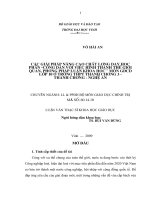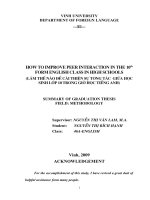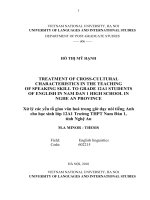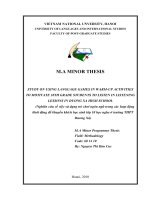Using games for the 10th form speaking clas in high school (the new textboook) = sử dụng trò chơi trong giờ học nói tiếng anh lớp 10 ở trường trung học phổ thông SGK mới
Bạn đang xem bản rút gọn của tài liệu. Xem và tải ngay bản đầy đủ của tài liệu tại đây (1.06 MB, 59 trang )
Vinh university
foreign languages department
phan thÞ kim sa
Using Games for the 10th Form Speaking
Class in High School
(The new textbook)
(sư dơng trß ch¬i trong giê häc nãi tiÕng anh líp 10
ë trêng trung häc phỉ th«ng - SGK míi)
Graduation thesis
Field: Methodology
Vinh, May 2007
1
Vinh university
foreign languages department
Using Games for the 10th Form Speaking
Class in High School
(The new textbook)
(sử dụng trò chơi trong giờ häc nãi tiÕng anh líp 10
ë trêng trung häc phỉ thông - SGK mới)
Graduation thesis
Field: Methodology
Student:
Phan thị kim sa
Supervisor: M.A Nguyễn Thị Vân Lam
Vinh, May 2007
ACKNOWLEDGEMENTS
The study would not have been completed without the invaluable assistance
and encouragement of many people for whom I am grateful.
I especially would like to express my deepest thanks to my supervisor, M.A.
Nguyen Thi Van Lam, whose useful instructions and advice, as well as detail
2
critical comments and encouragement have helped me a great deal from the
beginning to the end of the thesis writing process.
I also would like to thank to the teachers at the Foreign Languages
Department of Vinh University who have given me useful advice and favourable
conditions for the completion of the thesis.
My greatest debt is to Miss Mindy, who has wholeheartedly helped me
much with precious sources of materials.
My sincere thanks goes to all teachers of English and students in Nguyen
Xuan On High School and Dien Chau III High School who have helped me to
carry out the surveys for my thesis.
I am really in debt to my beloved family, my close friend's family and my
friends for their help and encouragement during the process of writing this
thesis.
Though the study has been done with all my attempts, my limitations of
ability and knowledge may cause mistakes in the thesis. Therefore, all comments
and remarks on the thesis would be highly appreciated.
Vinh, May 2007
Phan Thi Kim Sa
3
TABLE OF CONTENTS
Acknowledgements.........................................................................i
Table of contents............................................................................ii
abbreviations.....................................................................................v
Part I: introduction.......................................................................1
1. The Reasons for Choosing the Study.....................................................1
2. The Aims of the Study.............................................................................2
3. The Scope of the Study............................................................................3
4. The Methods of the Study.......................................................................3
5. The Design of the Study..........................................................................3
Part II: investigation.....................................................................5
Chapter I: theoretical background..................................5
1.1. Nature of Speaking...............................................................................5
1.2. Teaching Speaking in Communicative Language Teaching............5
1.2.1. Communicative Language Teaching (CLT)...................................5
1.2.2. Principles to Teach Speaking in CLT..............................................7
1.2.2.1. Principles for the Beginning Levels..............................................7
1.2.2.2. Principles for the Intermediate and Advanced Levels................8
1.2.3. Speaking Activities............................................................................9
4
1.2.3.1. Characteristics of a Successful Speaking Activity.......................9
1.2.3.2. Problems with Speaking Activities.............................................10
1.2.3.3. Solutions of the Problems with Speaking Activities..................11
1.3. Game....................................................................................................11
1.3.1. Definition..........................................................................................11
1.3.2. The Role of Games in Language Teaching and Learning Process12
1.3.3. Aims of Using Games in Speaking Class.......................................13
1.3.4. Difficulties for Teachers in Using Games in Speaking Class.......14
1.3.5. Principles of Using Games..............................................................15
1.3.6. Types of Games................................................................................17
chapter II: the survey.................................................................21
2.1. The Overview of the Survey..............................................................21
2.1.1. Aims of the Survey..........................................................................21
2.1.2. Informants and their Background.................................................21
2.1.2.1. The Teachers.................................................................................21
2.1.2.1. The Students.................................................................................21
2.2. Description of the Teachers...............................................................22
2.2.2. Questionaires for the Students.......................................................22
2.3. Survey Results and Data Analysis....................................................23
5
2.3.1. Survey Result from Teachers.........................................................24
2.3.2. Survey Result from Students..........................................................26
chapter III: some suggested games used for the 10th
form speaking class in high school..................................29
3.1. Some General Kinds of Games..........................................................29
3.1.1. Picture Games..................................................................................29
3.1.2. Memory Games................................................................................29
3.1.3. Guessing Games...............................................................................29
3.1.4. Matching-up Games........................................................................30
3.1.5. Story Games.....................................................................................30
3.1.6. Search Games..................................................................................30
3.1.7. Information gap Games..................................................................30
3.1.8. Quiz Games......................................................................................30
3.2. The procedures for Using Games......................................................30
3.2.1. The Purpose of the Activity............................................................30
3.2.2. The Procedures of the Activity.......................................................31
3.3. Some Samples Applied in "Tieng Anh 10" (The New Textbook)..31
part III: conclusion.......................................................................44
1. Recapitulation........................................................................................44
6
2. Suggestions for Further Studies...........................................................44
REFERENCES
APPENDIX
7
ABBREVIATIONS
CLT:
Communicative Language Teaching
Q:
Questions
A:
Answer
8
APPENDIX
Survey Questionnaire
(For Teachers)
This survey questionnaire is designed for the research into “Using Games for the 10th
Form Speaking Class in High School (The New Textbook)". Your cooperation in answering
the following questions is highly appreciated. This is for the study purpose only and you can
be sure that you will not be identified in any discussion of the data. Thank you for your
assistance.
Please fill some information about yourself:
Your age: _________
Your gender: (male /female)________
Your school: _________
Please circle the letter a, b, c, d where appropriate. For a certain number of
questions, you can circle more than one.
1. How long have you been teaching English?
a. 4 years
b. 5- 10 years
c. 10- 15 years
d. Over 15 years
2. Do you teach the 10th form this year?
a. Yes
b. No
3. What do you think about the new textbook?
a. The same
b. Easier
c. More difficult
d. Your own ideas: ……………………………………
4. How important do you think the speaking skill is among four skills?
9
a. Most important
b. As important as other skills
c. Less important than others
d. Your own ideas: …………………………………………
5. Are your students interested in speaking activities?
a. Very interested in
b. Not really interested in
c. Quite interested in
d. Bored with
6. Have you ever applied games into your teaching process?
a. Yes
b. No
7. How do you often organize the class when playing games?
a. Individually
b. Pair work
c. Group work
d. Class work
8. How often do you organize speaking activities through games for your
students?
a. Never
b. Sometimes
c. Usually
d. Rarely
9. What is the difficulty you find when organize a game in speaking class?
10
a. Mixed levels of students
b. Lack of time
c. Game preparation
d. Others
10.How do you think about the importance of games in speaking class?
a. Very important
b. Rather necessary
c. Not necessary
d. Your own ideas: …………………………………………
11.Which type of games is the most interesting for your students?
a. Picture games
b. Guessing games
c. Memory games
d. Your own ideas : …………………………………………
12. Could you give your own opinions about teacher's using games to
improve students' speaking skill?
…………………………………………………………………………………
……………………………………………………………………………………
……………………………………………………………………………………
…………
Thank you very much for your help!
11
Survey Questionnaire
(For Students)
This survey questionnaire is designed for the research into “Using Games for the 10th
Form Speaking Class in High School (The New Textbook)". Your cooperation in answering
the following questions is highly appreciated. This is for the study purpose only and you can
be sure that you will not be identified in any discussion of the data. Thank you for your
assistance.
Please fill some information about yourself:
Your age: _________
Your gender: (male /female)________
Your school: _________
Your class: _________
How many periods of English do you learn per week? _________
Please circle the letter a, b, c, d where appropriate. For a certain number of
questions, you can circle more than one.
1. How long have you been learning English?
a. 2 years
b. 5 years
c. 6 years
d. More than 6 years
2. Do you like learning English?
a. Very much
b. Not much
c. As much as others
d. Not at all
3. Which skill do you think is the most important?
a. Listening
b. Speaking
12
c. Reading
d. Writing
4. How do you like speaking English in class?
a. Very much
b. Quite a lot
c. A little
d. Not at all
5. Are you interested in speaking activities?
a. Very interested in
b. Not interested in
c. Quite interested in
d. Not at all
6. Have you ever played games in your speaking class?
a. Yes
b. No
7. How do you think about playing games in speaking class?
a. Very important
b. Rather necessary
c. Not necessary
d. Useless and wasteful time
8. Do you like playing games in speaking class?
a. Yes
b. No
13
Could you explain why/ why not?
…………………………………………………………………………………
……………………………………………………………………………………
………
9. How often does your teacher organize games in your class?
a. Never
b. Sometimes
c. Usually
d. Rarely
10.
Which type of games is the most interesting for you?
a. Picture games
b. Guessing games
c. Memory games
d.Your own ideas: ……………………………………………
Thank you very much for your help!
14
REFERENCES
English:
1.
Collins, G. (1980). Play Games with English. London: Longman Press.
2.
Doff, A. (1988). Teaching English: A Training Course for Teacher.
Cambridge: Cambridge University Press.
3.
Forseth, R. (1995). Methodology Handbook of English Teacher in
Vietnam. Hanoi English Language Institute: American Press.
4.
Hadfield, J. (1990). Intermediate Communication Games. England:
Addison Wesley Longman Ltd.
5.
Hadfield, J. (1999). Beginners' Communication Games. China:
Addison Wesley Longman Ltd.
6.
Harmer, J. (1991). How to Teach English. London: Longman press.
7.
Kay, S. (1998). Communicative Activities for Students of English.
Macmillan publishers Limited.
8.
McCallum, G.P. (1980). 101 Word Games. Oxford: Oxford University
Press.
9.
Nunan, D. (1991). Language Teaching Method. Prentice Hall Regents.
10.
Richards, J.C. & Rodgers, T.S. (2001). Approaches and Methods in
Language Teaching. Cambridge: Cambridge University Press.
11.
Rixon, S. (1981). How to Use Language Games in Language Teaching.
Macmillian Publishers Ltd.
12.
Stenton, A., & Lambert, S. (Eds.). (1985). Longman Dictionary of
Applied Linguistics. Great Britain: The Chaucer Press.
13.
Ur, P. (1995). A Course in Language Teaching: Practice and Theory.
Cambridge, New York and Melbourne: Cambridge University
Press.
14.
Ur, P. & Wright, A. (1992). Five-Minutes Activities. Cambridge
University Press.
15
Vietnamese:
Hoàng Văn Vân. (Ed.). (2006). Tiếng Anh 10. Hà Nội: Nhà Xuất Bản
Giáo dục.
Website:
http://
www.boardofed.idaho.gov/lep/documents/Idaho_Map_Levels_tall.pdf
Part I: introduction
1. The Reasons for Choosing the Study
Is it necessary to learn English? It cannot be denied that today English is the most widely
used language in the world. It bids fair to become an international language. It has been used
in all spheres of public activity. English brings people on earth close together.
In Vietnam, the situation is similar. The open door policy has brought good chances for
foreigners to invest into Vietnam and for tourists to pay visit to our country. Especially with
the event on November 7th, 2006, Vietnam became the 150th official member of World Trade
16
Organization, English has been more important than ever here. At most schools, English has
been considered to be one of the most necessary subjects for students at all levels of
educational systems. Therefore, educators have tried to find the most effective method in
teaching English as well as compiling a new textbook suitably with the general trend.
As can be seen from the reality, the Communicative Approach has become dominant. The
goal of language teaching here is the communicative competence. Thus, learners become
more active during the class time and learners-centered classroom is reached.
The old textbook has been applied for a long time and in English classes, the teachers are
mainly concerned with teaching the points covered in the examinations that students must
cope with, so they find it unnecessary to encourage students to speak English. When the
new textbook is published, four basis language skills: listening, speaking, reading and
writing are taught equally. However, in fact, in high schools, teachers are not used to
teaching with the new textbook. They find it difficult for themselves and for their
students. Actually, it is not easy to get students to talk in the target language. Thus, a big
problem is how to develop in students the ability to speak English so that they can use
English appropriately and naturally in class and in daily life.
Facing with that demand of methodology, teachers are required to be more careful and
skillful in preparing the lesson plan. To gain a successful speaking class, the very essential
element is motivation. Language games are regarded as effective communicative activities.
Therefore, they can bring opportunities for students to talk or they can encourage their
participation. In fact, many methodologists have conducted research on using games in
speaking classes. In Vinh University, there have been some graduation theses about these as
well. However, these materials are mostly applied for the old textbook.
Aware of the real situation of teaching English at high schools in Vietnam in general and
in Nghe An in particular, the author has attempted to conduct the study entitled "Using Games
for the 10th Form Speaking Class in High School (The New Textbook)" in the hope of
helping teachers maintain the interests of their students and motivate them to undertake tasks
to get the certain competence in using English. It is also her hope that the study could make
some contributions to a better situation of teaching and learning speaking skills in English.
2. The Aims of the Study
For the reasons mentioned above, the thesis has been done with the aims to:
17
Provide an overview on the Communicative Language Teaching
Approach and the nature of speaking skills
Present some general knowledge about teaching speaking in
Communicative Language Teaching
Give a more detailed framework of language games for teaching
speaking skill
Give some features of the situation of teaching and learning speaking
skills and using games in high school
Help teachers and students be aware of the role of using games in
speaking classes
Suggest some typical games for teaching speaking skills in some
specific lessons in "Tieng Anh 10" (The New Textbook).
3. The Scope of the Study
Game is too great a term to talk about. That is why it is impossible for the author to cover
all things related to the topic of the study. Only the most necessary knowledge about speaking
skills and some language games used to practice and develop speaking skills are mentioned in
the thesis. Furthermore, it is too broad to carry out the thesis discussing all levels of students.
Thus, the thesis only focuses on students of the 10th form at high school. What is more,
special attention is paid to the new textbook which is more difficult for teaching and learning
process.
4. The Methods of the Study
With the aim to develop speaking skill through language games, in the course of writing
this paper, the author has used the quantitative and qualitative with the following procedure:
Collecting information associated with speaking skills and games from different
sources: references, books, and Internet.
Conducting a survey on the real situation at high schools by using questionnaires
for both the teachers and students there.
18
Investigating and analyzing the results gained from the survey about the current
situation of teaching and learning speaking skills and using games in speaking
class in high school.
Synthesizing the survey results to suggest suitable games for speaking classes.
5. The Design of the Study
The study consists of three main parts:
Part I entitled "Introduction" outlines the background of the study. In this part,
information about the reasons for choosing the study, the aims, the scope, the method and the
design of the study are provided.
Part II with the title "Investigation" comprises three chapters. Chapter I, "Theoretical
Background", provides all concepts related to the study, ranging from the nature of speaking,
teaching English in CLT, games and others. Chapter II entitled "The Survey" is dealt with the
investigation of the factual situation of teaching and learning to speak English as well as using
games at Nguyen Xuan On High School in Dien Chau- Nghe An. Chapter III discusses some
suggested games using for the 10th form speaking class in high school.
Part III is the "Conclusion" which presents a brief overview on the achievement of the
thesis and suggests some extensive topics relating to the thesis.
The study ends up with "References" with a list of sources of materials and "Appendix"
with the questionaires of the surve
Part II: investigation
Chapter I: theoretical background
1.1. Nature of Speakin
Speaking is an interactive process of constructing meaning that involves producing and
receiving and processing information (Brown, 1994, Burn and Joyce, 1997). Its form and
meaning are dependent on the context in which it occurs, including the participants
themselves, their collective experiences, the physical environment and the purposes for
speaking.
19
Speaking skill is an oral productive skill. Of all the four basic language skills (listening,
speaking, reading and writing), it seems intuitively the most important. The people who know
a language are referred to as ‘speaker’ of that language, as if speaking included all other skills
of knowing and many if not most foreign language learners are primarily interested in
learning to speak.
1.2. Teaching Speaking in Communicative Language Teaching
1.2.1. Communicative Language Teaching (CLT)
The Communicative Approach, simply CLT, has expanded and seen as the most popular
approach in teaching and learning foreign languages in recent years with two aims. First, it
makes communicative competence the goal of language teaching. Then, it develops
procedures for the teaching of the four language skills.
Nunan (1991: 279) lists five basic characteristics of CLT:
1. An emphasis on learning is to communicate through interaction in the target
language.
2. The introduction of authentic texts used into the learning situation.
3. The provision of opportunities for learners to focus on which not only the
language but also the learning process itself.
4. An enhancement of the learner’s own personal experiences can be as important
contributing elements to classroom learning.
5. An attempt is to link classroom language learning with language activation
outside the classroom.
CLT starts from the communicative view of language in which language is a system for
the expression of meaning. The primary function of language is to allow interaction and
communication. The structure of language reflects its functional and communicative use. The
primary units of language consist of grammatical and structural features, categories of
functional and communicative meaning as exemplified in discourse.
Learning is promoted by activities that involve real communication promote learning or
by activities in which language is used for carrying out meaningful task and by language that
is meaningful to the learners. The goal of CLT is that learners will be able to use the language
20









